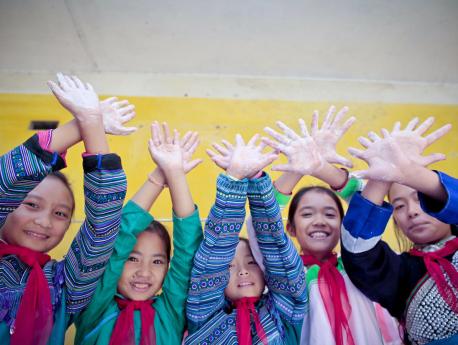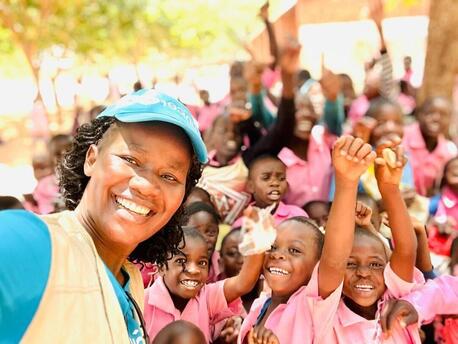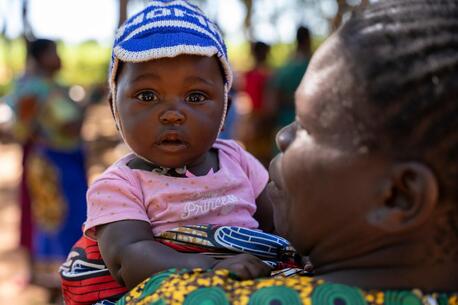
Keeping Children and Schools Safe Protects Us All
An education is a child's key to the future. UNICEF is working to make sure every student keeps learning during the coronavirus pandemic.
UPDATED March 23, 2020
Since the coronavirus disease (COVID-19) outbreak — now officially a pandemic — began in December, schools have closed nationwide in 130 countries, interrupting the lives and educations of more than 1.2 billion children and youth. In the U.S. alone, at least 54.8 million children have been affected by school closures. Many districts with internet access are shifting to remote learning.
"While temporary school closures as a result of health and other crises are not new unfortunately, the global scale and speed of the current educational disruption is unparalleled and, if prolonged, could threaten the right to education," Audrey Azoulay, Director-General of The United Nations Educational, Scientific and Cultural Organization (UNESCO) said on March 4.
As communities take action to prevent further transmission, reduce the impacts of the outbreak and support control measures, keeping students safe and learning must remain a top priority.
School closures come at a high price
So far, there have been relatively few cases of COVID-19 reported among children. In a March 13 op/ed in the Los Angeles Times, Robert Jenkins, UNICEF's chief of education, points out that, while public health officials may have good reason to close schools, there are serious consequences.
When a large number of schools were closed in West Africa between 2014 and 2016 during the Ebola crisis, families missed out on nutrition, disease prevention programs and access to water and sanitation, and sexual abuse and exploitation of children increased. UNICEF reopened schools, developing and implementing anti-Ebola measures such as daily temperature screenings and instruction on good hygiene practices, proving that even during a health crisis, children need not put their education on hold.

Student-members of the Health Brigade at the UNICEF-supported Dikolelayi Primary School in Kananga, Kasai-Occidental province, Democratic Republic of Congo (DRC). © UNICEF/UN0271256/Tremeau
COVID-19 calls for concrete child protection measures
As school closures and movement restrictions are disrupting children's routines and support systems, they are also adding new pressures on parents and caregivers who may have lost their jobs or be unable to work. “In many ways, the disease is now reaching children and families far beyond those it directly infects,” said Cornelius Williams, UNICEF Chief of Child Protection. “Schools are closing. Parents are struggling to care for their children and make ends meet. The protection risks for children are mounting."
To help authorities and organizations keep children safe and healthy amidst the intensifying socioeconomic fallout from COVID-19, UNICEF, together with its partners at the Alliance for Child Protection in Humanitarian Action, has written a guide providing concrete steps governments and protection authorities can take, including:
- increasing information sharing on support services for children
- training health, education and child services staff on how to recognize and prevent sexual exploitation and abuse and how to safely report concerns
- providing targeted support for interim care centers and families to protect children's emotional wellbeing and encourage self-care
- providing financial and material assistance to families whose incomes have been affected
- establishing measures to ensure that families remain together, and to protect children left without adequate care after the hospitalization or death of a parent or caregiver

Children going home after school in Kandahar, in the Southern region of Afghanistan.© UNICEF/UNI309837// Frank Dejongh
Preventing the potential spread of COVID-19 in schools
For those schools that remain open, UNICEF teamed up with the International Federation of Red Cross and Red Crescent Societies (IFRC) and the World Health Organization (WHO) to create a guide containing checklists for school administrators, teachers and staff outlining sanitation and disinfection practices. The guide also includes information on how parents can monitor children's health and help them cope with stress. The guide calls for:
- Providing children with information about how to protect themselves
- Promoting best handwashing and hygiene practices and providing hygiene supplies
- Cleaning and disinfecting school buildings, especially water and sanitation facilities
- Increasing airflow and ventilation
Spread the dance, not the disease. @UNICEF_vietnam#COVID19#coronavirus#ghencovychallengepic.twitter.com/DNemPakmtZ
— UNICEF (@UNICEF) March 12, 2020
Fighting the spread of stigma
UNICEF works in 144 countries around the world to provide children and adolescents with the knowledge and skills they need to thrive. As we work to protect children from harmful viruses, we must also protect them from stigma and abuse linked to COVID-19 fears. During disease outbreaks, it's more important than ever to spread kindness and support one another.
Viruses are equal opportunity. They cannot target people from specific populations, ethnicities or racial backgrounds. Students and staff who may have been exposed to the virus should feel comfortable about coming forward to seek testing and treatment. Education settings should continue to be welcoming, respectful, inclusive and supportive environments to all.
Measures taken by schools can prevent the entry and spread of COVID-19 by students and staff who may have been exposed to the virus, while minimizing disruption, protecting students and staff from discrimination and offering children a powerful example of how people can work together for the common good in a time of crisis.
Your gift will help UNICEF be there for vulnerable children around the world during the coronavirus global health emergency.
Top photo: Students from the UNICEF-supported Muong Khuong Boarding School in Lao Cai, Vietnam proudly show their clean hands after they've washed them with soap and clean water. © UNICEF/UNI310705/Viet Hung
HOW TO HELP
There are many ways to make a difference
War, famine, poverty, natural disasters — threats to the world's children keep coming. But UNICEF won't stop working to keep children healthy and safe.
UNICEF works in over 190 countries and territories — more places than any other children's organization. UNICEF has the world's largest humanitarian warehouse and, when disaster strikes, can get supplies almost anywhere within 72 hours. Constantly innovating, always advocating for a better world for children, UNICEF works to ensure that every child can grow up healthy, educated, protected and respected.
Would you like to help give all children the opportunity to reach their full potential? There are many ways to get involved.





